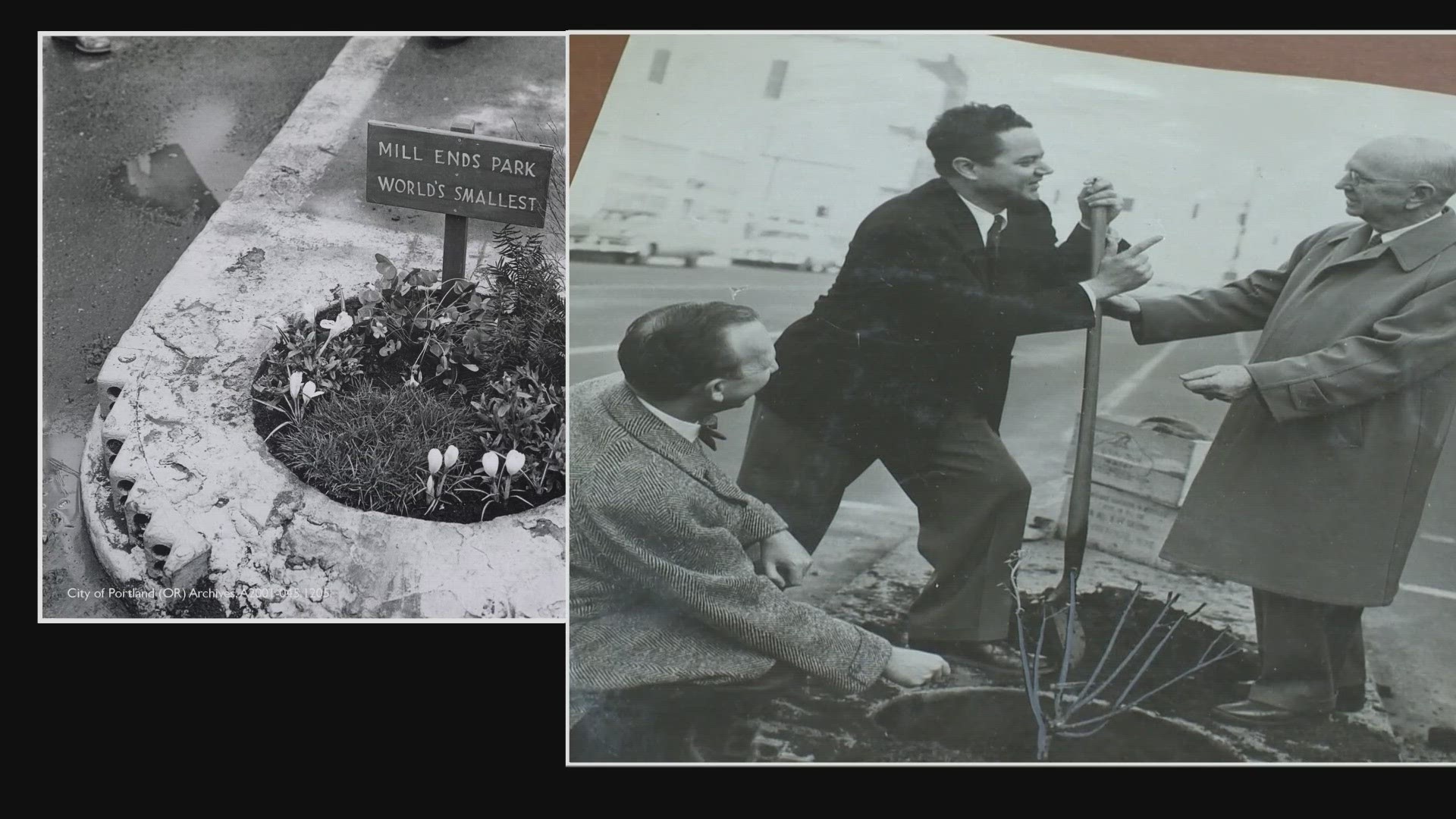PORTLAND, Ore. — Seventy years ago, the city of Portland turned a small hole in a median along what was then Northwest Front Avenue into a garden. If it wasn't for a creative reporter and his Irish heritage, Mill Ends Park wouldn't be what it is today.
Mill Ends Park now sits in the middle of Naito Parkway where it meets up with Taylor Street.
"It's a very prestigious spot. It's very well-known for how small it is," said Daniel Misner, a horticulturalist with Urban Forestry.
For four years, while Misner was Portland Parks and Recreation, Mill Ends was his park to take care of.
"I really view as kind of an honor to be able to maintain it and have that be part of my legacy with Portland Parks," Misner said.
Before Mill Ends Park became a city park, it was just a hole that was supposed to be a light pole. That light pole never appeared. Instead, it filled with weeds.
Enter Dick Fagan, a general news reporter and former editor of the Oregon Journal. On January 28, 1947, Fagan was asked to write a column. He called it Mill Ends, named for the odd end pieces of cut lumber at a lumber mill.
"His column consisted of a lot of, should we say, odds and ends," said Pat Fagan, one of his sons.


One day, Dick Fagan looked out his second-story office window at the Oregon Journal building and noticed the hole filled with weeds.
"He just kept looking at that day in and day out and said, 'Something's got to be done here. This isn't right,'" Pat Fagan said.
This is where the story took a whimsical turn. Dick Fagan reportedly saw a leprechaun digging in that hole and after he caught it, was granted three wishes. One of them was to have his own park, but he never said how big the park should be. So the leprechaun gave him the weed-filled hole. Dick Fagan named it Mill Ends Park and gave it the title, "world's smallest."
"He spruced it up with a couple rose bushes, a few marigolds around," Pat Fagan said.
While the park started as just a planted piece of dirt, it was in 1954 when Portland tried to cement its reputation as the Rose City. Officials with the city planted a Portland Envoy rose bush in that spot. The city referred to it by a different name.


"The city tried to give it the name of Envoy Park," Misner said.
Dick Fagan didn't like the name change. In his column the next day, he wrote that the officials had "The temerity, meaning audacity, to claim that this plot of land is Portland Envoy Park instead of Mill Ends Park. By which it has been named for lo these many years."
"I could see where dad would say, 'Hey, that's not going to fly," Pat Fagan said.
Dick Fagan's daughter, Carolyn Litson, added how he may have likely reacted: "Like over my dead body, you're going to rename that park.'"
The name of Mill Ends Park stuck and it also became a regular topic in his column.
On one hand, Mill Ends was was a mini rose garden. On the other hand, it turned into a fantasy land, home to a resident leprechaun named Patrick O'Toole.
"He'd talk to the leprechauns," Litson said.
"He's the only one that did," Pat Fagan added.
"He's the only one that could," Bill Fagan said.


Just like the whimsical and obscure nature of his column, so were the events that took place in it, like the time two cowboys planted a Texas Rose in the spot, or a miniature Ferris wheel for leprechauns was lowered into the park by a construction crew using a large crane. Then there were the annual snail races held every St. Patrick's Day.
"That was always a big, annual event. Dad would come home and he would go and get mom's good china and he'd take it down there and he'd place the snails on the plate and race," Litson said.
"Who else is gonna have a snail race?" Pat asked with a smile.
On April 23, 1968, Dick Fagan's column took a more serious tone. He wrote, "I have cancer in the upper left lung."
"He worked and wrote the column for as long as he could," Litson said. "He enjoyed making people, just happy events. Making people happy."
Dick Fagan would continue writing his Mill Ends column until his death in 1969. The day after he passed away, the paper printed a cartoon letting their readers know. The cartoon drawing was of a leprechaun sitting in Mill Ends Park with his head hanging down while holding a shamrock.
"We lost him too early. I think it was too early for Portland, too," Litson said. "He had a lot he could make them laugh about and smile."
In 1971, the Guinness Book of World Records recognized Mill Ends Park as the world's smallest park. It measures at just 452 square inches.
Five years later, and fittingly enough on St. Patrick's Day, the park officially became a city-owned and maintained park in 1976.
"I don't think he ever imagined that it would become what it has. It would have brought a smile to his face because this wasn't just leaving us a legacy as a family. This is to the people he loved and the city he loved."
Every year on St. Patrick's Day, the family gathers to honor their dad at the park he helped create.
"I think he'd be proud and happy that we still recognize it," Bill Fagan said.
The park has largely remained in the same spot for 70 years. It was temporarily removed in 2006 for construction on Naito Parkway. In 2021, it was moved again, that time six inches west of the original location and was given its own sign.
VIDEO PLAYLIST: What's in a Name?

